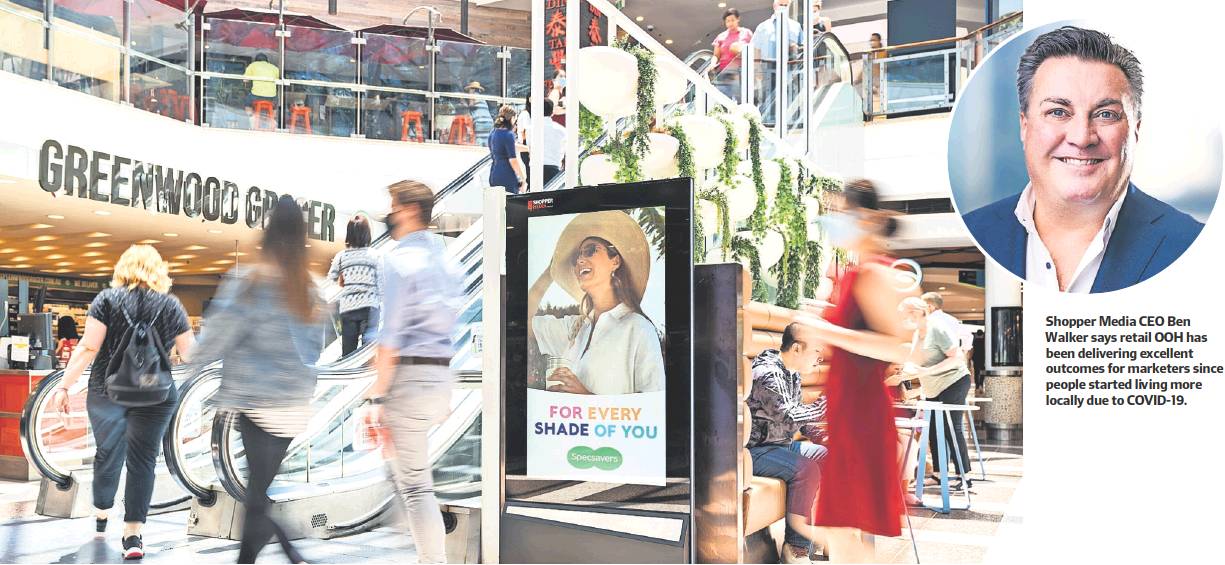Retail digital signage the new hot spot
The COVID-19 pandemic put a wrecking ball through the out-of-home (OOH) advertising industry, but changes in shopping habits created opportunities for digitally enabled media companies.
The OOH sector in Australia saw a 24 per cent fall in the first half of 2020, according to industry analytics service Standard Media Index.
But retail’s share of OOH spending in 2020 rose by 4.5 per cent to 24.6 per cent, leap-frogging street furniture for the first time and narrowing the gap with billboards.
Work-from-home and lockdowns caused marketers to shift their spend from OOH media such as street furniture and airport billboards, a traditionally effective location for OOH, to local shopping centres, which became the new destination for Australians, and particularly Victorians, who cited the desire to get out of the house in a safe way.
These factors made digital OOH signage in local shopping centres the new hot spot for marketers wanting to personalise ads and make them contextually relevant to offline audiences.
Personalisation at scale can now be achieved by offering ads that zero in on a local audience at the right time and in the right location. Advertisers can roll out different messages in shopping centres where they will be most effective. Contextually relevant advertising is a trend that offers ads triggered by weather or time of day to target different segments of shoppers.
Several non-COVID-19 factors are also making retail OOH an attractive market.
A recent Shopper Media study found that 40 per cent of shoppers purchased something after seeing it advertised on retail screens, and a Nielsen DOOH survey last year found that 70 per cent of those who saw an OOH ad in the shopping centre, visited the store.
Digital ads in shopping centres cannot be turned off or blocked and with Google phasing out thirdparty cookies, marketers are looking for new ways to align messages with what customers want.
‘‘The rise of retail OOH has been a strong factor driving the growth over the last eight years, and that was never more so than during COVID-19,’’ says Shopper Media founder and CEO Ben Walker.
‘‘When clients worried about campaigns and marketing budgets, they needed a media format that was dynamic and that was digital OOH in local shopping centres. There was a strong decline in classic inventory and static posters, but retail OOH offered excellent outcomes for marketers because people started living locally, a trend I believe will continue in 2021.’’
Shopper Media is a 100 per cent digital ad solution with more than 400 local shopping centres in its network Australia-wide. Its datadriven ShopperAi platform, alongside Wi-Fi and virtual bluetooth beacons in centre, means it can capture significant amounts of data and target shoppers precisely.
‘‘During COVID-19 the Wi-Fi technology allowed us to see every device in our centres in real time, and in the weeks when panic-buying started, our audience went up 15 per cent,’’ Walker says.
‘‘When the panic-buying calmed, we saw dwell times increase, which makes perfect sense because if you remember we had to line up to get into the shopping centre.’’
More than 160,000 people have logged on to Shopper Media’s Wi-Fi, enabling the company to collect data on postcodes, sex and age. It then surveys shoppers to gauge consumer appetites and enable personalisation at scale.
‘‘We created and completed a media multiplier survey recently, asking whether ads in centre reminded people of ads on television. Thirty-two per cent of people often notice advertising for brands they recall from TV and about 64 per cent of people said they would like to be reminded of new products when at the shopping centre,’’ Walker says.
He expects the media multiplier effect to continue to drive effectiveness for advertisers, after the company’s research found consumers were more than twice as alert to ads outside the home.
The company is also leading the conversation on animated advertising.
‘‘Big clients are not using animation enough. We’re having conversations about how brands can have a considerably bigger impact in shopping centres,’’ Walker says.
Shopper Media is adopting the new wave of programmatic trading for digital OOH, a format that allows buyers to purchase ad slots on a digital sign in a shopping centre online.
It currently makes up 3 per cent of Shopper Media revenue, but Walker says that should jump to double digits next year.
‘‘It allows us to tap into pools of money that weren’t traditionally spent in OOH, capturing brands who want to reach audiences in retail centres in real time with scale and efficiency,’’ he says.
‘‘Programmatic digital OOH is creating a convergence of online and offline touchpoints, delivering omni-channel buying and real-time analysis and reporting of campaigns.’’
